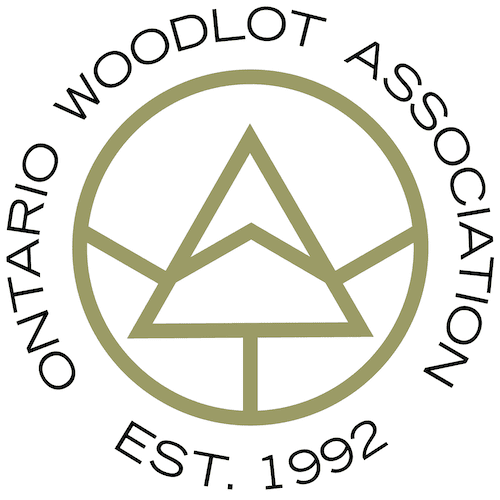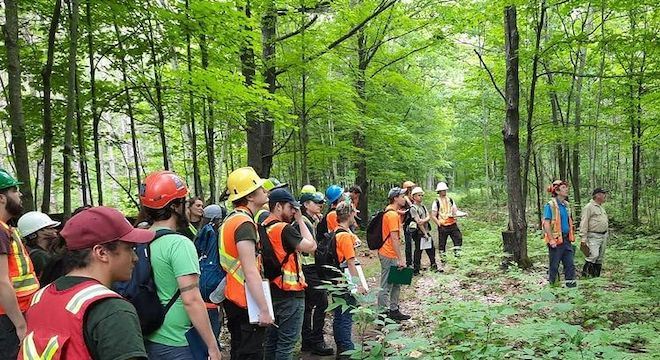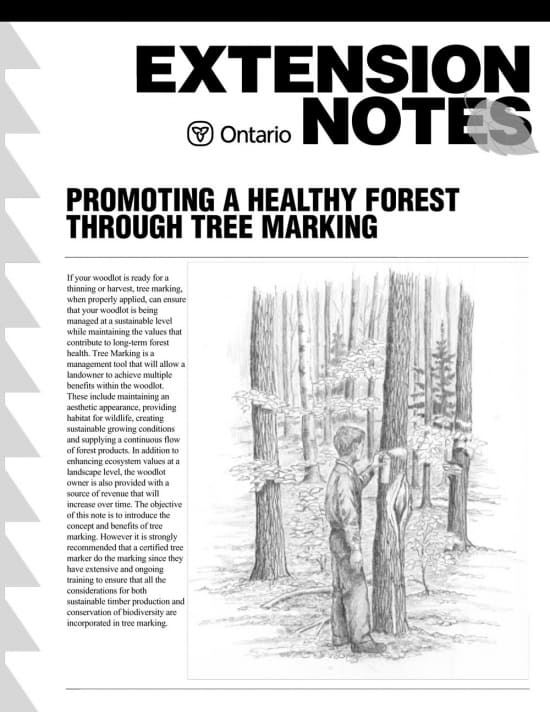- Home
- Member Resources
- Woodland 101
- FOREST MANAGEMENT - TREE MARKING
Tree Marking |
Experience has shown us that poorly managed forests will not produce quality forest products or good wildlife habitat. Often these shortcomings can be attributed to undesirable harvesting practices that have taken place in the past. Cutting trees is an important management tool that can be used to enhance the health and biodiversity of a forest. However, for harvesting to be effective it must be done in a manner that is consistent with good forestry practices. This can be best achieved through a good tree-marking plan. What is tree marking?Tree marking involves the careful selection of trees for harvest (under a partial cutting system), based on a forest management prescription. Specific trees are selected to be cut or left, based on their growth potential, ability to provide seed or wildlife benefits in the forest. This selection process takes into consideration numerous individual tree characteristics, not just tree size. Each tree to be cut is marked with paint to ensure that the prescription is followed. What is a forest management prescription?A prescription describes a series of actions to be taken to meet the management objectives (e.g., improve growth and quality of the forest, ensure regeneration, provide wildlife habitat, etc.) for a specific area based on an assessment and inventory of that area. Or you can think of it simply as a recipe that provides instructions to be used by the tree marker, in making 'cut and leave' decisions of individual trees, based on good forestry practices. To successfully meet your harvesting objectives, tree markers must make use of their expertise in accurately interpreting the prescription and applying it to the specific conditions found in your forest. What are the advantages of having my forest marked?Having your forest marked by a qualified tree marker is an important step that links your forest management prescription with the actual harvesting operations. Here are some of the advantages: Tree marking identifies to the logger what is to be harvested and what is for sale; A qualified marker can mark your forest in a manner that will maintain a healthy forest and work towards ensuring that a new forest of desirable species grows after cutting. Not all trees are created equal and a small tree is not always a younger tree. Many of the small trees in your woodlot are small because of their age. However, the size of a tree may also be due to poor genetics, stunted growth or site characteristics. It takes years of experience to tell the difference, and an experienced tree marker can provide you with this expertise. Tree markers can identify the trees in the woodlot that should be retained to provide valuable wildlife habitat and to maintain biodiversity (e.g., cavity trees). Tree marking, based on sound forest management principles, will optimize your economic return and enhance future timber quality and quantity (to ensure a continuous and predictable supply of timber products and source of revenue); and Tree marking done in conjunction with good forestry practices has the capacity to ensure the long-term sustainability of your forest What are the limitations of tree marking?Tree marking alone will not prevent 'high-grading' (where the largest most valuable trees are cut leaving behind the less valuable or poorer quality trees in the forest). Virtually anyone with a can of spray paint can sell their services as a tree marker. It is only when tree marking is applied in conjunction with good forestry practices that the opportunity for high-grading can be minimized. Why is tree marking not based solely on tree diameter?A harvest based solely on cutting the biggest and the best trees (diameter cutting) can easily be considered a high-grade operation. A more detailed explanation is available in Forest Management for Income - Making Financial Sense. Where should the markings be applied?Trees should be marked at breast height (with a painted band around the bole) and at the base (butt) of each tree, extending from ground level up approximately 30-40 cm. The band at breast height makes the marked trees easy to see from all angles in the forest. The butt mark provides an indicator that can be used to ensure that only marked trees have been removed during harvest. Yellow paint is used in most harvesting operations (on private land) to identify the trees to be cut. Blue paint is used to identify trees to be retained (e.g., for wildlife habitat) and red paint is used to identify property boundaries. Check with your logger to ensure that there is a clear understanding of the colour scheme being used to mark the trees in your forests. What is a certified tree marker?Since 1995, the Ontario Ministry of Natural Resources (MNR) has provided tree marking certification training. The training involves a one-week course covering silvicultural systems, silviculture, silvics, wildlife habitat, tree defects and tree vigour characteristics. Participants are field tested, and successful trainees are issued a certificate endorsing their skills as a certified tree marker (of conifer forests, hardwood forests or both). To maintain MNR's certification, a tree marker must attend and successfully complete a two-day refresher course every three years. Why hire a certified tree marker?It is important to realize that a tree marker's skills play a significant role in the decision-making process (when identifying which tree should be removed from your forest during harvest operations). Their decisions can directly influence the long-term economic and ecological integrity of your forest. For this reason, a good tree marker must be knowledgeable and skilled. They must be able to properly assess a tree's quality and vigour, its value in terms of grade and product and its potential as a tree for wildlife habitat or for maintaining biodiversity. Hiring a certified tree marker ensures a proven level of competency in carrying out this important task. However, experience can also be important. For example, you may wish to hire a certified tree marker who has several years of experience in marking hardwood forests if your woodlot is predominantly hardwood. |



